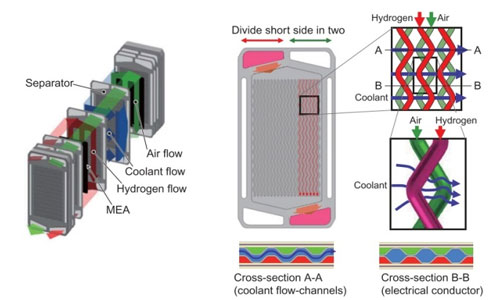
The rotary die cutter used in the production process of renewable energy fuel cells works in a similar way to the laser rotary die cutter described earlier. However, there are a few differences in terms of the materials used and the cutting process. Here is a description of how the rotary die cutter works in the context of renewable energy fuel cells:
1. Preparation: Similar to the laser rotary die cutter, the machine is set up with the desired cutting parameters, such as the cutting pattern and speed. The cutting parameters may vary depending on the type and thickness of the fuel cell materials.
2. Material Loading: The fuel cell materials, such as the membrane electrode assembly (MEA), gas diffusion layers (GDL), and bipolar plates, are loaded onto the machine. These materials are typically in the form of sheets or rolls.
3. Feeding: The material is fed into the rotary die cutter, which consists of a rotating cylinder or drum. The material is guided through the machine using mechanisms such as rollers or belts to ensure precise positioning.
4. Cutting Process: As the material passes through the machine, a cutting die is used to cut the fuel cell materials into the desired shapes and sizes. The cutting die can be customized to match the specific requirements of the fuel cell components. The die is mounted on the rotating cylinder or drum, and as it rotates, it cuts the material into the desired shapes. The cutting die can have various designs, such as blades or punches, depending on the specific application.
5. Waste Management: During the cutting process, excess material or waste is generated. The rotary die cutter includes mechanisms to efficiently remove this waste, such as suction or other methods. This ensures that only the desired fuel cell components are produced, minimizing material wastage.
6. Quality Control: After the cutting process, the fuel cell components are inspected for quality control purposes. Any defective or damaged components are identified and removed from the production line.
7. Finished Product: Once the cutting process is complete and quality control checks are passed, the fuel cell components are collected as finished products. These components can then proceed to the next stage of the fuel cell manufacturing process, which may involve further treatments or assembly to form complete fuel cells or fuel cell stacks.
The rotary die cutter enables efficient and precise cutting of the fuel cell materials, allowing for the mass production of renewable energy fuel cells. It enhances productivity, reduces material wastage, and contributes to the overall manufacturing process of renewable energy fuel cell systems.
Contact: Pamela
Phone: +86 189 6365 3253
E-mail: info@industryprocess.com
Whatsapp:+86 189 6365 3253
Add: Yajing Industrial Park, No. 59 Shuangjing Street, Weiting Town, Suzhou Industrial Park
We chat
